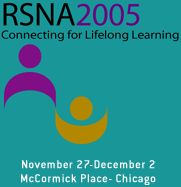
Abstract Archives of the RSNA, 2005
SSK02-03
MRI Assessment of Vascular Smooth Muscle Cell Endovascular Therapy in a Rat Model of Abdominal Aortic Aneurysm: Immediate and Long-term Follow-up
Scientific Papers
Presented on November 30, 2005
Presented as part of SSK02: Vascular/Interventional (MR Angiography)
Jean-françois Deux, Presenter: Nothing to Disclose
Jianping Dai, Abstract Co-Author: Nothing to Disclose
Charlotte Rivière, Abstract Co-Author: Nothing to Disclose
Eric Allaire, Abstract Co-Author: Nothing to Disclose
Frank Philippe Boudghene MD, PhD, Abstract Co-Author: Nothing to Disclose
Didier Letourneur, Abstract Co-Author: Nothing to Disclose
Cell therapy is another approach for the treatment of abdominal aortic aneurysm (AAA), since local endovascular delivery of vascular smooth muscle cells (VSMCs) in experimental rat aneurysm stops aortic dilatation. However the fate of cells after injection remains unclear. In this work we used magnetically labeled vascular smooth muscle cells to validate and follow by magnetic resonance imaging cell therapy of AAA in rats up to one month after local delivery.
Iron anionic magnetic nanoparticles were used to labeled rat smooth muscle cells. PKH26 was used as a fluorescent tag for a dual label after iron labeling. Experimental abdominal aortic aneurysms (n=16) were created by xenograft of guinea pig aorta into rats. Two weeks after surgery 10exp6 iron labeled smooth muscle cells were seeded into the lumen of grafts through a transverse arteriotomy. Six control rats received unlabeled cells or iron free particles in solution. 1.5T MRI with T2* gradient echo images was performed before cells delivery, at Day 0, Day 7, Day 14 and Day 28. Two aortas were imaged ex vivo on a 9.4T MRI system. Histological analysis and immunochemistry were performed after MRI.
Immediately after iron labeled SMC delivery, T2* weighted gradient echo images evidenced circumferential hyposignal intensities areas on the wall of the abdominal aortic aneurysm in all rats. No hyposignal areas were detected in control rats. Hyposignal areas persisted up to 28 days that also correlated to the stabilization of anevrysm diameter. A decrease of signal loss was noticed from Day 0 to Day 28. High field MRI at Day 28 revealed hyposignal areas in the deep portion of aortic wall, well correlated with localization of iron loaded cells in histology. Immunochemistry revealed double staining of some iron loaded cells with smooth muscle cells, but macrophages containing iron were also detected in the adventicia.
Cell therapy of abdominal aortic aneurysms can be assessed by MRI using iron labeled cells. Prolonged detection of iron labeled cells is possible up to 28 days after injection. The precise fate of seeded SMC remains to study at long term in the remodeling phase of AAA after cell therapy.
Deux, J,
Dai, J,
Rivière, C,
Allaire, E,
Boudghene, F,
Letourneur, D,
MRI Assessment of Vascular Smooth Muscle Cell Endovascular Therapy in a Rat Model of Abdominal Aortic Aneurysm: Immediate and Long-term Follow-up. Radiological Society of North America 2005 Scientific Assembly and Annual Meeting, November 27 - December 2, 2005 ,Chicago IL.
http://archive.rsna.org/2005/4411203.html

